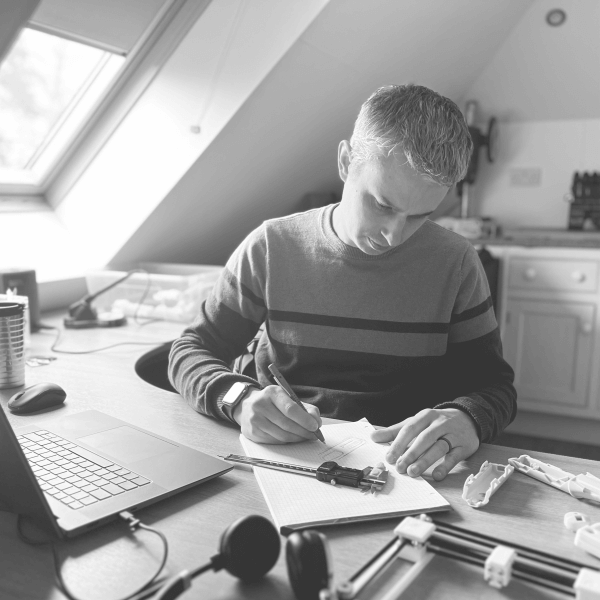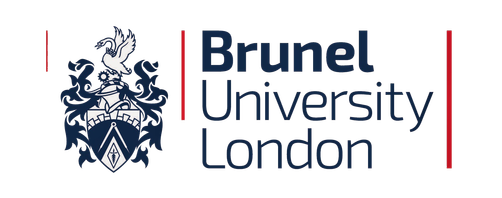
Nigel Hinson is a highly motivated multi-disciplined industrial designer,
engineer, maker, coder, and inventor with over two decades of collective
experience across the automotive, mobile, consumer electronics, and silicon
industries. Possessing a hands-on practical approach and a keen eye for detail.
Nigel is based in the south coast of England with his wife and three children
in Lymington, a seaside town nestled in the heart of the New Forest.
Passionate about technology and driven by a desire to create, Nigel
realised his long-held dream of establishing his own design-related
business in 2024 when he founded MechElecSoft Ltd. His professional journey
is marked by significant contributions to pioneering products and technologies,
earning him credits as an inventor on numerous patents.

He studied Industrial Design and Technology at Brunel University UK, graduating with a First Class BA (Hons) degree in 2003. A notable achievement during his academic tenure was the construction of an origami folding machine as his major project. He also gained practical experience during his year in industry, where he contributed to the design, testing, and production implementation of car mirrors for European Toyota Avensis and Corolla models at Schefenacker Vision Systems.

Nigel then went on to working for leading appliance manufacturer
Dyson, contributing to the development of various new products.
Notable highlights during his tenure include:
DC12 - First Dyson Japanese Cylinder Vacuum Cleaner
Assisted with the final design stage, building and assembling rapid
prototypes, working on modifications, and providing feedback to the
design team for final tooling. Also, he aided with pre-production
builds, user trials, and testing.
DC16 - First Handheld Vacuum
Played a key role in the design team, with specific responsibility
for the motor bucket assembly. He collaborated closely with the
computational fluid dynamics team to design the motor impeller and
ducting, as well as with the electronics team to house the drive
circuitry. Various prototypes, including multi-axis CNC, rapid
prototyping, both SLS and blue stone SLA, were produced. The assembly
was fully designed, validated, tooled, and put into production in
record time.
Dyson Robot (Early versions of the 360 eye)
Participated in the development of various versions of the Dyson
robot. Overseeing extreme life testing of mains electrical cable
management/handling systems, he also conducted R&D work into new
robot systems, resulting in a patent for a method of emptying a
robot bin. He had responsibility for the motor bucket assembly
and user interface controls on a later battery robot, which evolved
into the 360 eye.
New Product Development
Contributed to the development of various home appliance concepts,
including small domestic appliances for the kitchen.

In 2006, he joined Quantum Research Group, where he focused on
integrating capacitive touch solutions into a diverse array of
products, ranging from smartphones to industrial equipment.
He was part of the team that pioneered the integration of capacitive
touch technology into the first smartphones for Samsung, LG, and
Motorola. Over the years, he contributed to the development of
hundreds of capacitive touch sensor designs for various tier 1
customers, including:
Acer | B&O | Casio | Dell | Electrolux | Epson | Foxconn | GE | Gigaset
| HP | HTC | Huawei | Indesit | Lenovo | Lexmark | LG | Logitech | Meizu
| Microsoft | Motorola | Nokia | Novero | Nvidia | Pure Digital | RIM |
Samsung | Sharp | Siemens | Sirius | Sony | Tomtom
He engaged in R&D activities to explore new sensor pattern ideas,
resulting in the acquisition of multiple patents. Additionally,
he played a key role in the development and promotion of the QTouch
range of buttons, sliders, and wheels.
He initiated the development of automation processes for touchscreen
layout, creating the first parametric electrode layouts within
Solidworks linked to Excel.
Furthermore, he was responsible for designing and manufacturing
high-quality marketing demonstration units in both high and low
volumes, collaborating closely with marketing and sales teams.
Nigel worked with the in-house workshop team to produce new
units (including machined, lasered, and injection-molded parts)
and retrofit sensors into existing consumer products. His
responsibilities included generating detailed assembly and part
drawings and utilising in-house 3D printers for rapid part production.
Additionally, he conducted product teardowns for competitor analysis.

In 2008, Atmel acquired Quantum Research Group, and Nigel continued
to be part of the team that played a pivotal role in launching the
1st maXTouch chip and related touch solutions to the market in 2009.
This chip, along with its subsequent derivatives, emerged as the
top-selling touch device worldwide in the years to follow.
He persisted in advancing the automation capabilities for touch
sensor design, developing VBA scripts within Excel to generate
DXF geometry for electrodes, as well as within Corel Draw. A significant
achievement in this endeavor was the full automation of outer traces/tracking
entirely within Excel (an impressive xls!).
He engaged in ongoing R&D efforts to explore new sensor pattern
ideas aimed at addressing challenges such as noise re-transmission,
thinner stacks, and single layers.
Nigel also developed Python scripts to automate geometry and stack
generation within Ansys Q3D for capacitance extraction simulation.
Continuing his commitment to creating high-quality marketing
demonstrations and test equipment for application engineers, he
developed automated test solutions.
In 2013, he took on the role of lead mechanical engineer for the
development of Atmel’s maXStylus capacitive touchscreen stylus.
This involved conceptual work, designing evaluation units, and
providing direct customer support in Asia during production ramp-up,
which included multiple trips to China and Taiwan.

As a Principal Development Engineer within the Human Machine Interface
Division of Microchip, Nigel was a key player in the development of new touch
technologies and systems.
He independently conceived, designed, and developed the Microchip Touch
Sensor Portal, a global web-based tool utilised daily by the HMI Business
Unit for designing touch sensors. This portal fully automates the sensor
design process. Initial project data is entered via webpages, and full
custom 2D sensor manufacturing files are generated along with 3D sensor
simulation geometry for import into Ansys Q3D and CapExt for simulation.
All sensor and simulation data are stored, traceable, and accessible
within the system. Technologies utilized include Python, PHP, Javascript,
HTML, MySQL, and Linux, with outputs including SVG, DXF, Altium, CapExt,
Ansys files, and PDF reports.
Focusing on the automotive and industrial markets, he collaborated on
sensor designs for various OEM suppliers such as Alpine, Bosch,
Continental, and Valeo to name a few.
Nigel also served as the HMI Demonstration Designer, creating showcase HMI
demonstrator units which included mechanical design and demo software.
A notable achievement was the building of the CES 2020 Automotive centre
console demo, which went on to showcase Microchip's latest HMI technology
at trade shows worldwide.
He contributed to the mechanics for capacitive force sensing, including
simulating and fabricating evaluation units.
As the mechanical expert for Microchip's HMI Knob on Display technology,
Nigel developed and designed prototypes for firmware engineers and evaluation
units for customers, alongside automated test equipment.
He innovated pattern generators for odd-shaped sensors while maintaining
node areas during pattern distortion.
Nigel also developed workflows to automatically build in-cell metal mesh sensors
from Python scripts, generating GDSII and DXF files along with 3D
simulation files. He built optimizers to iterate through the entire
design cycle to find the optimum sensor pattern, all on a Linux compute farm.